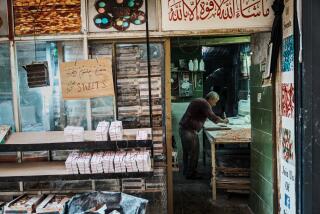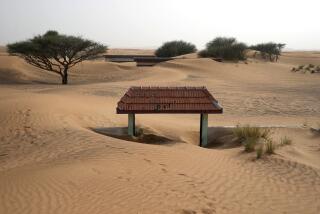Oman Fans the Embers of a Bygone Trade
- Share via
SALALAH, Oman — In a dry stream bed a few thousand yards from the craggy seacoast of southern Arabia, the dun-colored desert is relieved by a few splashes of green.
From a distance, the flat-topped wild trees resemble acacias. But crouch beneath their leafy confines and a bit of magic happens: A subtle, piney fragrance imparts a feeling of health and well-being.
This is frankincense, Boswellia sacra, which for reasons of climate and soil grows to perfection in the Dhofar region of southern Oman. It is a shrub that once made members of tribes here among the richest people on Earth.
When the biblical Three Wise Men journeyed from the East bearing their gifts of frankincense, myrrh and gold to Jesus in the manger of Bethlehem, they were offering the greatest treasures of their age.
And, according to scholars, frankincense--actually the resin taken from the frankincense tree and burned as incense--was at that time the rarest and most valuable of the three.
The trade continues today, though barely. The sultanate of Oman is searching for ways to resuscitate a market for its holy smoke.
Though frankincense will always be associated with Christmas, it was so costly at the time of the Nativity because it was essential to pre-Christian rites.
For hundreds of years, it was ordered by the ton for ancient pharaohs, kings and emperors, carried at high cost across the seas or the sands of Arabia, to be burned by high priests in the temples of Egypt, Greece, Persia and Rome. It was used for embalming by the ancient Egyptians, and its scent helped to perfume the cremations of ancient Rome.
And the land that became Oman at the southeastern edge of the Arabian peninsula held the monopoly. So intense was the desire to protect this source of income that the people of this region guarded the secret of the trees’ locations and promulgated legends that the plants were guarded by flying serpents that would kill intruders.
Recent excavations and archeological discoveries have shed new light on the extensive frankincense trade of that era. The area was then governed by Sheba (now Yemen). According to local lore, the biblical queen of Sheba ordered the construction of ports from which frankincense could be sent west or east.
In addition, there was an overland trade route through Arabia to Gaza, with stations at intervals for resting and watering pack animals. When the frankincense trade diminished around AD 300 due to the rise of Christianity--the early Christians associated it with paganism--these once-thriving settlements collapsed back into the sand.
Mahmoud bin Badr Abri, director general of Oman’s Public Authority for Marketing Agricultural Produce, has the job of building up frankincense exports from their present minuscule level of 5 tons a year, just one-fifth the amount reportedly ordered by the king of Persia alone in 500 BC.
Abri said frankincense is still used in Roman Catholic and Greek Orthodox services and by some European perfume houses. In parts of Arabia it is burned in homes as a fragrance and to ward off misfortune.
The trade in Oman is barely hanging on, in part because the local product has been undercut by cheaper competition coming from trees in Somalia and India. The grade of frankincense produced elsewhere is inferior, Abri insists, but in today’s world there are few cognoscenti who can discern the difference.
Another problem is that for most modern-day Omanis, the hard work of repeatedly tapping the gum from the trees and then repairing the bark is not worth the effort. In the Salalah incense souk, even the purest white frankincense, hojari, can be bought in bulk for about $2.25 a pound, leaving little profit margin once the laborers are paid.
Abri is concentrating on the tourist market, selling frankincense together with enameled clay incense burners and experimenting with more modern packaging. Oman also has developed a frankincense-based line of perfume, Amouage, which costs $150 for a vial containing less than 2 ounces.
Abdelkadir Qassani, an expert here on frankincense who boasts that he regularly drinks water mixed with the gum as a calming tonic, said it is sad to see the trade now close to extinction.
“Thirty to 40 years ago, it used to account for 75% of the income of this region, but today it is not even worth mentioning,” he said. “People today are more interested in the Internet and globalization.”
More to Read
Sign up for Essential California
The most important California stories and recommendations in your inbox every morning.
You may occasionally receive promotional content from the Los Angeles Times.













